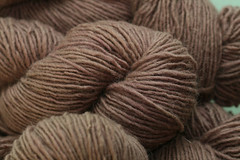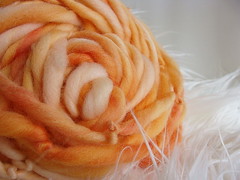Wool: Wool is a very popular fiber used in a variety of projects from scarves to socks. The fleece used to spin wool yarn comes from different breeds of sheep and different shearing. Wool is very warm, comes in a washable variety (superwash) and can also be used for felted projects. Some people are allergic to wool though, and others find pure wool itchy and harsh to work with.

Fleece: Fleece is a term used for the fleece of animals other than sheep. Common yarns are mohair, cashmere, and other angora blends. The fleece used to spin these yarns comes from goats and rabbits. These yarns are incredibly soft and work up quickly, making luxurious items. These yarns are generally more expensive.

Synthetic: The most common synthetic yarn is acrylic, which can vary in quality from brand to brand. It is a very easy yarn to work with. Acrylic can be washed/dried in appliances and is also very inexpensive, making it a popular yarn choice for baby projects, pet projects, afghans, and other well-loved items. Acrylic yarns come in a dazzling array of colors and all yarn weights. The downside is since acrylic is plastic, the yarn can lack the softness and definition of other fibers. It also will melt if heated, so using acrylic for a project such as a potholder would not be appropriate.

Cotton: Cotton yarn is also referred to as kitchen yarn. Most items you would find use for in a kitchen or bathroom (such as washcloths, towels, etc) are made from kitchen cotton yarn. This yarn is machine washable, absorbs water well, and holds up to wear. Cotton is a wonderful yarn to use for garments as well, due to its softness. But keep in mind that cotton does shrink when machine washed/dried.

Novelty: Novelty yarns are fun yarns to use for various projects. They are extremely different from traditional yarns. Some examples of novelty yarns are ribbon, boucle, chenille, fake fur, and thick-thin yarn. These are fun yarns to play with for projects such as a “fur” scarf, boucle blankets, and textured thick-thin hat.
Thick-thin:

Boucle:

Fake fur:

Blends: There are many variations of blended yarns. These yarns blend two or more yarn fibers together to maximize positive attributes and minimize the negative attributes of each yarn. Common blends are cotton/acrylic, wool/acrylic, cotton/bamboo, wool/nylon/spandex, etc. There are countless ways to blend yarns, so you will find many varieties!
Bamboo blend:

There are other yarns that have not been mentioned here, but these are some of the basic fibers that are frequently used. Familiarize yourself with the large variety of fibers available and, if you are able, go to a local yarn shop so you can see and feel the different yarn fibers. This will help you to develop your yarn eye.
Happy yarn shopping!
No comments:
Post a Comment